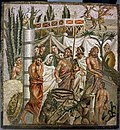
Iphigenia was the daughter of Agamemnon and Clytemnestra. According to the story, Agamemnon committed a mistake and had to sacrifice Iphigenia to Artemis to appease her. [1] There are different versions of the story. According to one side of the story, before Agamemnon could sacrifice her, Artemis saved her and replaced her with a deer on the altar. In the other version, Agamemnon actually went through with the sacrifice. The different versions aid in the different depictions of Iphigenia.
Contents
- Lost artworks described in Ancient literature
- Pausanias
- Pliny the Elder
- Iphigenia in art
- Volute krater of the sacrifice
- Mosaic of Iphigenia
- Iphigenia in Aulis
- Iphigenia in Tauris
- References
The sacrifice of Iphigenia is immortalized on many different mediums. Vases are a common base for the story, but there are mosaics, paintings, and written works from every era illustrating the myth of Iphigenia. The most common scene depicted in the different visual media of Iphigenia is when she about to be offered up to Artemis on the altar.











